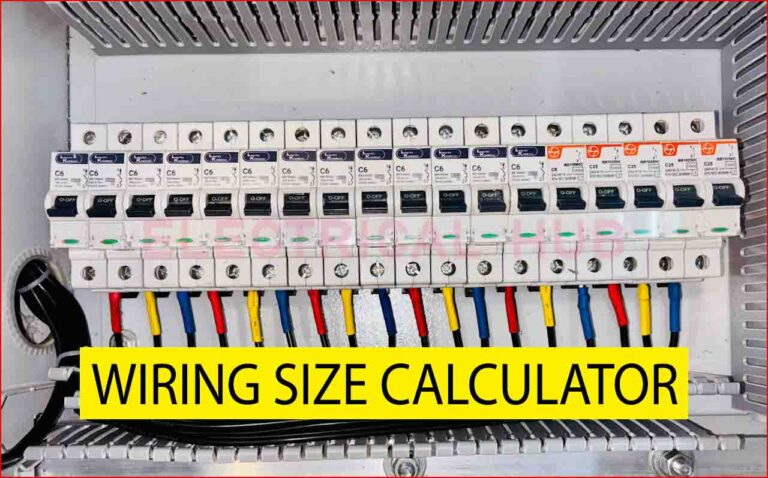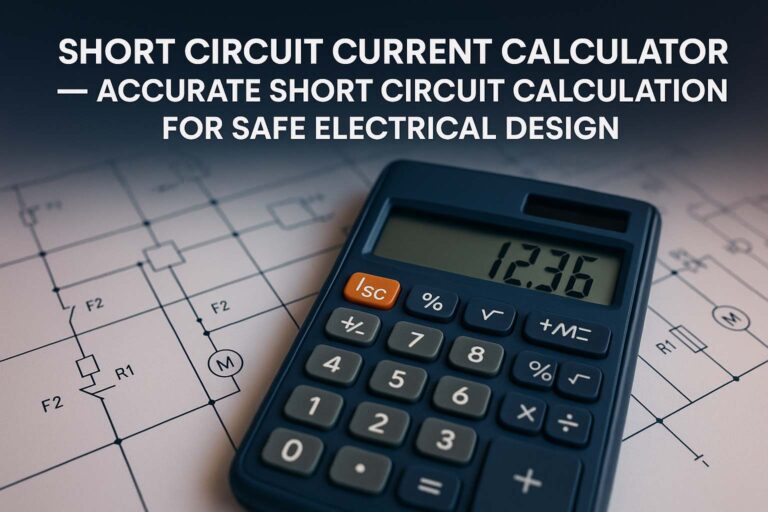Conduit Fill Calculator for Multi Conductor Cable: Accurate NEC-Based Cable Sizing Tool
Choosing the right conduit size is one of the most important steps when installing electrical wiring systems. A conduit fill calculator for multi conductor cable helps electricians, engineers, and contractors determine how many cables can safely fit inside a given conduit.
It ensures compliance with the National Electrical Code (NEC), prevents overheating, and reduces installation errors. Understanding how this calculator works and how to apply it in real installations can save both time and cost while ensuring safety and efficiency.

Table of Contents
What Is a Conduit Fill Calculator for Multi Conductor Cable
A conduit fill calculator for multi conductor cable is a tool designed to determine the percentage of space that electrical wires or cables occupy inside a conduit. Every conduit type—whether PVC, EMT, RMC, or flexible metal; has a maximum allowable fill percentage. The NEC sets these limits to prevent excessive heat buildup and mechanical damage.
For single conductors, the calculation is straightforward. However, for multi conductor cables, such as THHN, NM-B, or armored cables, the process becomes more complex. That’s where the conduit fill calculator simplifies things. It automatically considers cable diameter, conduit type, and number of conductors to find the best fit.
Conduit Fill Calculator for Multi Conductor Cable
Conduit Fill Calculator (NEC)
Calculate conduit fill percentage for multi-conductor cables based on NEC Chapter 9, Table 1 and Table 4.
Select your conduit type and size. Enter the outer diameter of the cable and the number of conductors. Click “Calculate” to view the total area occupied, fill percentage, and NEC compliance status. Use this to verify conduit sizing and avoid overfill violations.
Why Conduit Fill Calculation Matters
Proper conduit fill is not only a code requirement but also essential for system performance. Overfilled conduits make it difficult to pull cables and can cause insulation damage. They may also trap heat, which leads to increased conductor resistance and energy losses.
If a conduit is too large, installation costs increase unnecessarily. Therefore, using a conduit fill calculator for multi conductor cable helps you strike the perfect balance between safety, compliance, and cost efficiency.
NEC Guidelines for Conduit Fill
The National Electrical Code (NEC) defines conduit fill limits based on the number of conductors:
- One conductor: maximum fill of 53% of the internal area
- Two conductors: maximum fill of 31%
- Three or more conductors: maximum fill of 40%
These percentages apply regardless of conduit type. However, different materials have different internal diameters, so the actual size varies.
Use our online tool Electricity Load Calculator (kVA) According to IEC and NEC
Below is an example table based on NEC guidelines for conduit fill:
| Number of Conductors | Maximum Fill Percentage | Application Example |
|---|---|---|
| 1 | 53% | Single power cable |
| 2 | 31% | Two control cables |
| 3 or more | 40% | Multi conductor circuit cables |
These limits ensure sufficient air circulation and space for easy cable pulling.
How a Conduit Fill Calculator for Multi Conductor Cable Works
A conduit fill calculator for multi conductor cable uses three main inputs:
- Cable type and size (e.g., 12 AWG THHN, 10 AWG NM-B)
- Number of cables or conductors
- Conduit type and size (e.g., EMT, PVC, RMC)
The calculator then computes the total cross-sectional area of all cables combined. It compares that with the internal area of the selected conduit and determines whether the fill percentage is within the NEC limit.
For example, if you have three 12 AWG THHN conductors inside a ¾-inch EMT conduit, the calculator will determine that the fill percentage is about 40%, which is acceptable.
This method eliminates manual calculation errors and ensures code compliance instantly.
Example of Conduit Fill Calculation
Let’s understand with a practical example using the conduit fill calculator for multi conductor cable:
Suppose you are running four 12 AWG THHN conductors through a PVC conduit.
- Cross-sectional area of 12 AWG THHN = 0.0133 in²
- Total area for 4 conductors = 4 × 0.0133 = 0.0532 in²
- Internal area of ½-inch PVC conduit = 0.304 in²
- Maximum fill for 3+ conductors = 40% × 0.304 = 0.1216 in²
Since 0.0532 in² is less than 0.1216 in², the conduit size is sufficient.
This simple example shows how an electrical conduit fill calculator ensures quick and reliable verification of your conduit size.
Common Conduit Types and Their Fill Capacities
When using a conduit fill calculator for multi conductor cable, it is crucial to select the correct conduit type. Each type has a different internal diameter, which affects the calculation.
| Conduit Type | Common Use | Material | Typical Fill Efficiency |
|---|---|---|---|
| EMT (Electrical Metallic Tubing) | Indoor wiring | Steel | High efficiency |
| PVC (Polyvinyl Chloride) | Outdoor or underground | Plastic | Good insulation |
| RMC (Rigid Metal Conduit) | Heavy-duty environments | Galvanized steel | Lower flexibility |
| FMC (Flexible Metal Conduit) | Temporary or mobile setups | Aluminum or steel | Lower fill rate |
Using the right conduit ensures better protection and easier installation.
Use our online tool MM to AWG Wire Size Calculator According to IEC and NEC
Benefits of Using a Conduit Fill Calculator for Multi Conductor Cable
A conduit fill calculator for multi conductor cable offers multiple benefits:
- Time efficiency: Instantly determines proper conduit sizes without manual formulas.
- Code compliance: Ensures all installations meet NEC fill limits.
- Reduced rework: Prevents costly mistakes in cable pulling and sizing.
- Safety assurance: Minimizes heat buildup and insulation damage.
- Optimized material use: Avoids oversizing conduits that increase cost.
These calculators are especially useful for electricians working with large wiring systems, data centers, or industrial setups where cable density is high.
Manual Method vs Online Calculator
Traditionally, electricians used NEC tables and manual math to determine conduit fill. This process was time-consuming and prone to error.
In contrast, an online conduit fill calculator for multi conductor cable performs instant calculations. Most modern calculators also allow users to input different cable types, insulation thicknesses, and conduit materials, giving more accurate results.
While manual methods are useful for understanding the basics, professionals rely on digital tools for speed and accuracy.
Use our online tool Cable Bending Radius Calculator – Accurate Minimum Bend Radius for Electrical Cables
Typical Applications of Conduit Fill Calculators
Conduit fill calculators are used across multiple industries and applications:
- Residential wiring systems – for power, lighting, and control circuits
- Commercial buildings – for data, HVAC, and power distribution systems
- Industrial facilities – for control panels, motor feeders, and instrumentation
- Solar power systems – to size conduits for multiple PV cables
- Telecommunication setups – to route multi-core communication cables safely
These calculators are essential wherever multiple conductors share a conduit path.
Tips for Accurate Conduit Fill Calculation
To get the most accurate results from a conduit fill calculator for multi conductor cable, follow these best practices:
- Always use the manufacturer’s exact cable dimensions instead of nominal sizes.
- Include all conductors, including neutrals and grounds, in your calculation.
- Account for derating if cables are in hot environments.
- Consider future expansions when sizing conduits.
- Use separate conduits for power and data cables to reduce interference.
Applying these tips ensures that your installations are safe, scalable, and compliant.
Use our online tool Sub Panel Wire Size Calculator – Accurate Wire Gauge & Load Sizing Tool
Selecting the Right Conduit Size
Choosing the right conduit size depends on the number of cables, the conductor size, and installation conditions. The following table provides a quick reference for commonly used combinations:
| Cable Size (AWG) | Number of Conductors | Recommended EMT Conduit Size (inches) |
|---|---|---|
| 14 AWG | Up to 9 | ½ inch |
| 12 AWG | Up to 6 | ¾ inch |
| 10 AWG | Up to 4 | ¾ inch |
| 8 AWG | Up to 3 | 1 inch |
| 6 AWG | Up to 3 | 1¼ inch |
This table is an approximation and should be verified using a conduit fill calculator for multi conductor cable to ensure code compliance.
Conclusion
A conduit fill calculator for multi conductor cable is an essential tool for anyone dealing with electrical wiring and conduit installations. It ensures that the system remains compliant with NEC standards, prevents overheating, and allows for easy maintenance. By using the calculator correctly, professionals can achieve safer installations, lower material costs, and improved efficiency.
Use our online tool Cable CSA Calculator UK – Accurate Electrical Cable Sizing by Load & Length
Whether you are planning a residential setup or designing complex industrial wiring, always rely on a conduit fill calculator for multi conductor cable before pulling wires. It’s a simple step that guarantees long-term safety, performance, and compliance with electrical standards.
Follow Us on Social:
Subscribe our Newsletter on Electrical Insights to get the latest updates in Electrical Engineering.
#ConduitFillCalculator, #MultiConductorCable, #ElectricalWiring, #NECStandards, #CableSizing, #ConduitCapacity, #ElectricalCalculator, #ConduitFillChart, #CableManagement, #WireInstallation, #ElectricalDesign, #IndustrialWiring, #CableFill, #ElectricalEngineering, #ConduitCalculator





